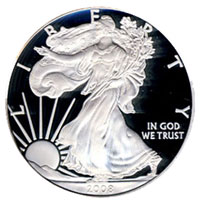 Although gold and silver are experiencing a sharp decline today, they recorded strong performance during the second quarter of 2010. Platinum and palladium both posted declines for second quarter, but maintain gains for the year to date.
Although gold and silver are experiencing a sharp decline today, they recorded strong performance during the second quarter of 2010. Platinum and palladium both posted declines for second quarter, but maintain gains for the year to date.
The table below shows the last London Fix Price of 2009 for each metal and the last price for June 30, 2010 followed by the percentage gain or loss for the 2010 Second Quarter and the Year to Date performance.
| 2009 Close | June 30, 2010 Close | 2nd Quarter | YTD | |
| Gold | $ 1,087.50 | $ 1,244.00 | 11.52% | 14.39% |
| Silver | $ 16.99 | $ 18.74 | 7.09% | 10.30% |
| Platinum | $ 1,461.00 | $ 1,532.00 | -6.87% | 4.86% |
| Palladium | $ 393.00 | $ 446.00 | -6.89% | 13.49% |
Gold recorded the largest gain for the most recent quarter with an increase of 11.52%. It is also showing the strong performance out of the four metals for the year to date, up 14.39%. During 2009, the other three metals had outperformed gold by wide margins.
Silver posted a gain of 7.09% for the quarter and is up 10.30% for the year to date. Notably, silver has now posted a gain for the past six consecutive quarters. This represents the longest quarterly winning streak which took place through the beginning of 1980 when silver had eleven consecutive quarters of gains.
Platinum and palladium showed declines of 6.87% and 6.89% for the quarter. Year to date numbers remain positive at 4.86% and 13.49%.
 Today the US Mint began accepting orders from authorized purchasers for the 2010 Gold and Silver Eagle bullion coins. The initial ordering date this year comes a bit later than usual and carries some special stipulations.
Today the US Mint began accepting orders from authorized purchasers for the 2010 Gold and Silver Eagle bullion coins. The initial ordering date this year comes a bit later than usual and carries some special stipulations. Yesterday, some very significant news broke which put to rest long standing speculation about the status of some of the United States Mint’s bullion and collector coin product offerings. Essentially, the United States Mint canceled all collectible 2009 Gold and Silver Eagle Coins, but announced the limited production of collectible proof 2009 Platinum Eagles and Gold Buffalo Coins, as well as bullion fractional Gold Eagles and one ounce Gold Buffalo coins. I will be breaking this announcement down into several posts over the next few days.
Yesterday, some very significant news broke which put to rest long standing speculation about the status of some of the United States Mint’s bullion and collector coin product offerings. Essentially, the United States Mint canceled all collectible 2009 Gold and Silver Eagle Coins, but announced the limited production of collectible proof 2009 Platinum Eagles and Gold Buffalo Coins, as well as bullion fractional Gold Eagles and one ounce Gold Buffalo coins. I will be breaking this announcement down into several posts over the next few days. For countless months, authorized purchasers of US Mint gold and bullion coins have been subject to a rationing process, which limited the number of coins they could purchase. The rationing program had been put into place after the demand for gold and silver coins exceeded the US Mint’s ability to supply them. In a few recent posts I have provided some indications that the shortage of American Silver Eagles and American Gold Eagles
For countless months, authorized purchasers of US Mint gold and bullion coins have been subject to a rationing process, which limited the number of coins they could purchase. The rationing program had been put into place after the demand for gold and silver coins exceeded the US Mint’s ability to supply them. In a few recent posts I have provided some indications that the shortage of American Silver Eagles and American Gold Eagles